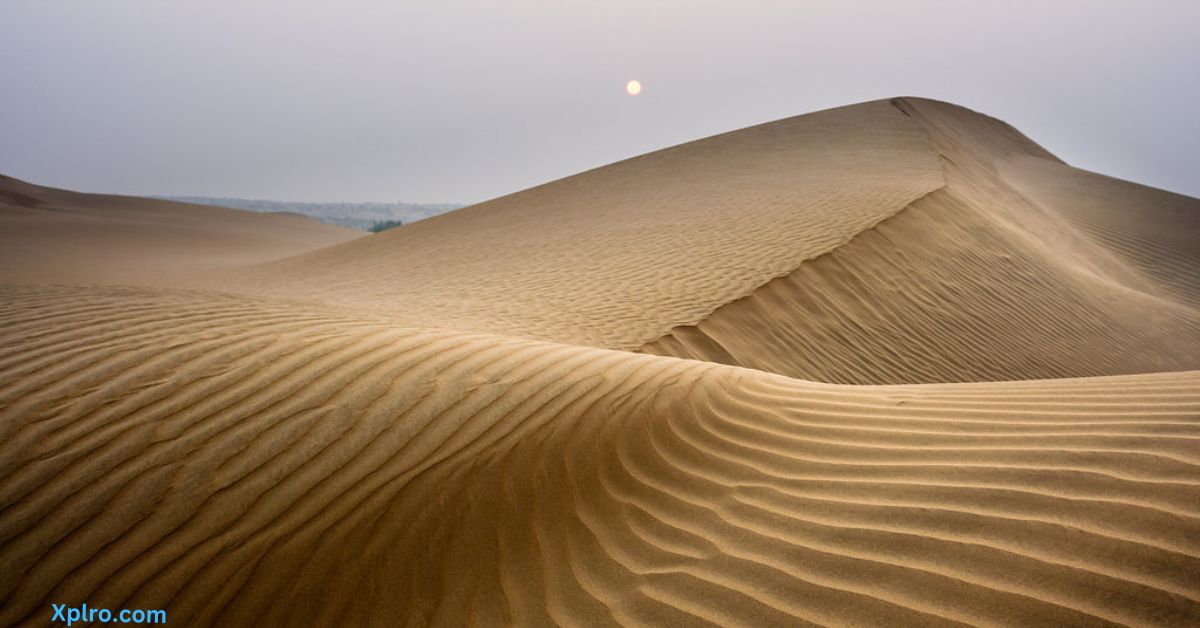In the beating heart of Rajasthan, India, lies the Thar Desert. Its timeless allure beckons adventurers with landscapes of endless golden sands, vibrant cultures, and a captivating history whispered on the wind. Sprawling over 200,000 square kilometers, the Thar, also known as the Great Indian Desert, is a mesmerizing tapestry. Arid plains are dotted with majestic forts, bustling villages, and a surprising abundance of life. This unforgiving land showcases not just the resilience of nature, but also the enduring spirit of the Rajasthani people. Their lives are intricately woven into the fabric of this harsh yet beautiful terrain. Here, every horizon promises a new tale – a captivating blend of heritage, adventure, and the untamed beauty of India’s desert jewel.
How to reach:
By Air: Jodhpur Airport, also known as Maharaja Bhagat Singh Airport, acts as the aerial gateway to the Thar Desert. Flights connect Jodhpur to major Indian cities like Delhi, Mumbai, Jaipur, and Udaipur. Once you land, road transportation whisks you to various desert locales.
By Train: Jodhpur’s another claim to fame is its bustling railway station. Trains snake their way from Delhi, Jaipur, Mumbai, and Ahmedabad, depositing you right at the desert’s doorstep. Taxis and buses then ferry you to Jaisalmer, Bikaner, or other desert gems.
By Road: Rajasthan boasts a well-developed road network, making road trips to the Thar Desert a breeze. National highways and state roads connect major cities like Jodhpur, Jaipur, Bikaner, and Jaisalmer. Private taxis, buses, and rental cars are abundant in these cities, ready to take you wherever your desert adventure awaits. Remember, planning ahead, especially during peak season, ensures a smooth journey.
Local: Within desert towns and villages, a vibrant tapestry of local transport awaits. Auto-rickshaws and cycle-rickshaws zip you around, while taxis tackle slightly longer distances. For a truly immersive experience, hop on a camel or jeep safari. These traditional modes of transport not only unveil the desert dunes but also offer a glimpse into Rajasthan’s rural charm.
Best time to visit:
Winter Wonderland (October to February):
- Tourist Paradise: This is the golden period to visit. Expect comfortable days with temperatures ranging from 25-30°C, and pleasantly cool nights. Perfect weather for sightseeing!
- Sightseeing Bliss: Explore the majestic dunes, forts, and cultural gems of the Thar without the summer’s scorching heat sapping your energy.
- Festival Fever: Immerse yourself in Rajasthan’s vibrant culture during winter festivals like the Jaisalmer Desert Festival (usually held in February).
Monsoon’s Touch (July to September):
- Sporadic Showers: The monsoon brings occasional rain showers, transforming the desert with a brief burst of green. However, humidity rises, and temperatures remain moderate.
- Unpredictable Travel: Heavy rains can cause road closures and limit access to some areas. Travel during the monsoon can be unpredictable and is less favored by tourists.
Attractions:
Sam Sand Dunes:
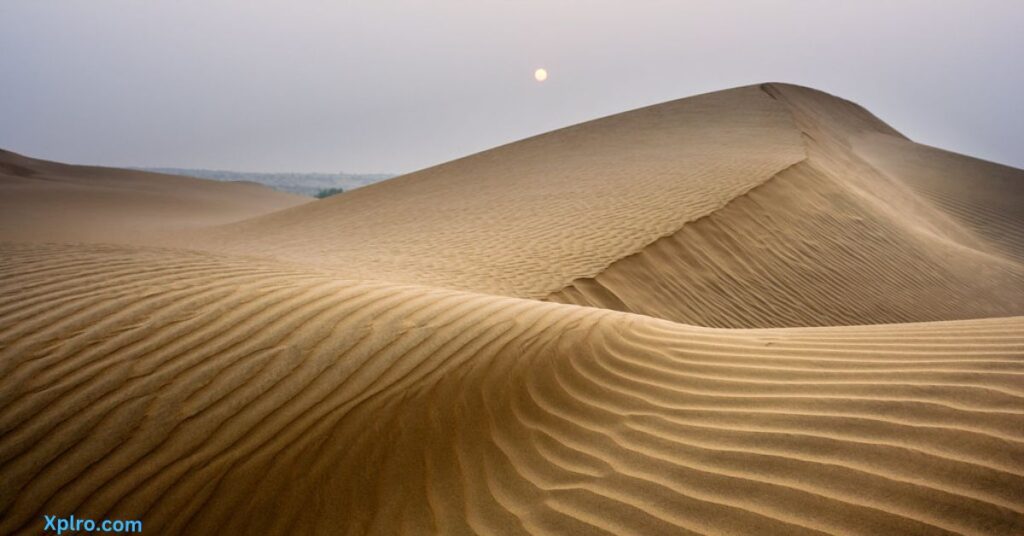
Step outside the bustling city of Jaisalmer and a scene straight out of a dream unfolds. The Sam Sand Dunes beckon, a sea of golden sand rippling endlessly towards the horizon. Here, adventure ignites. Embark on a swaying camel safari, feeling the rhythm of the desert beneath you. Or, for a rush of adrenaline, hurtle across the dunes in a jeep, the wind whipping through your hair.
The ever-shifting sands, sculpted by the desert winds, create a wonderland to explore. But the true magic unfolds as the sun dips below the horizon. The sky explodes into a fiery spectacle, painting the dunes in a breathtaking display of color.
Thar Desert Wildlife Sanctuary:
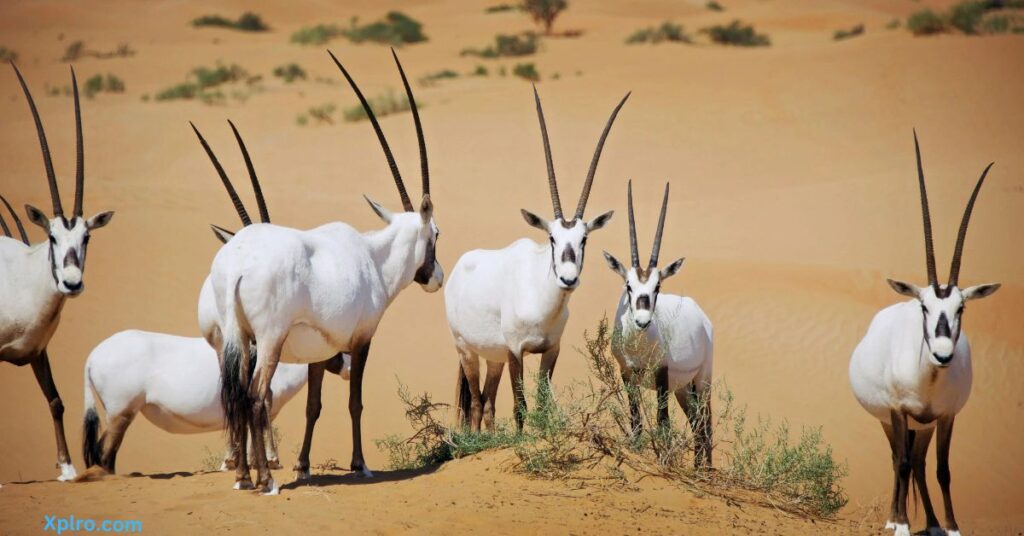
Deep within the heart of the Thar Desert lies a secret haven for nature lovers – the Thar Desert Wildlife Sanctuary. This sanctuary, stretching across Rajasthan’s western border, is a refuge for a surprising array of desert creatures. Here, the majestic blackbuck gracefully leaps across the sands, while the elusive chinkara, or Indian gazelle, blends seamlessly into the arid landscape. Desert foxes, with their keen eyes and cunning nature, prowl the dunes, adding another layer of intrigue to this unique ecosystem.
The sanctuary isn’t just about charismatic mammals. The air thrums with the songs of a myriad of bird species, each playing their part in the delicate desert balance. Saline lakes and scrublands, alongside the ever-present sand dunes, create a tapestry of habitats that sustains this remarkable biodiversity.
Desert National Park:
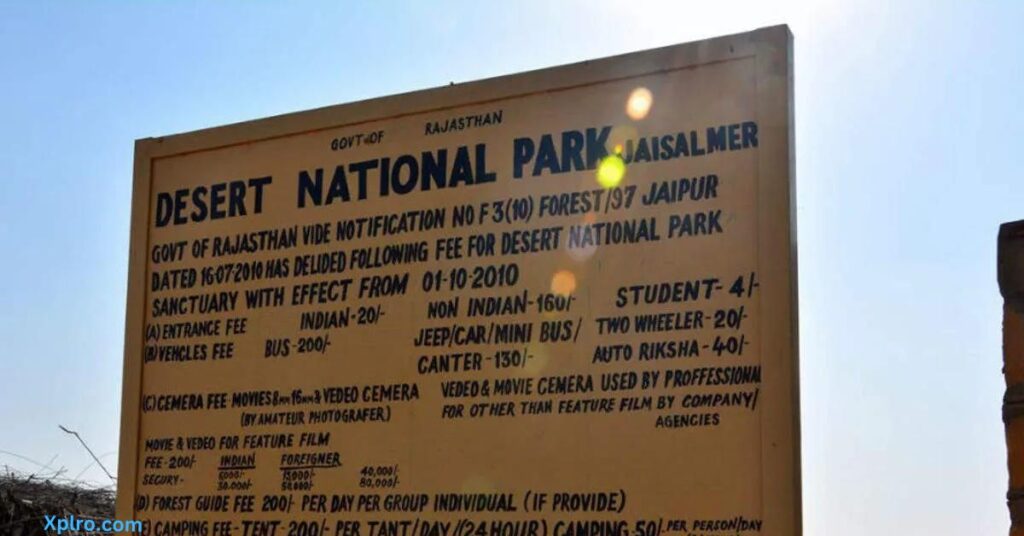
Unveiling a different side of the Thar Desert, Desert National Park, near Jaisalmer, is a captivating wilderness refuge. Sprawling over 3,000 square kilometers, this park is a treasure trove of biodiversity waiting to be explored.
Golden sands roll into dramatic rocky outcrops, while seasonal salt lakes, called ‘dhands’ by the locals, add a unique touch to the landscape. The park is a haven for endangered species, with the majestic Great Indian Bustard gracing its plains. Desert foxes and cats weave through the arid vegetation, while a fascinating array of reptiles complete the desert ecosystem.
Kuldhara Village:
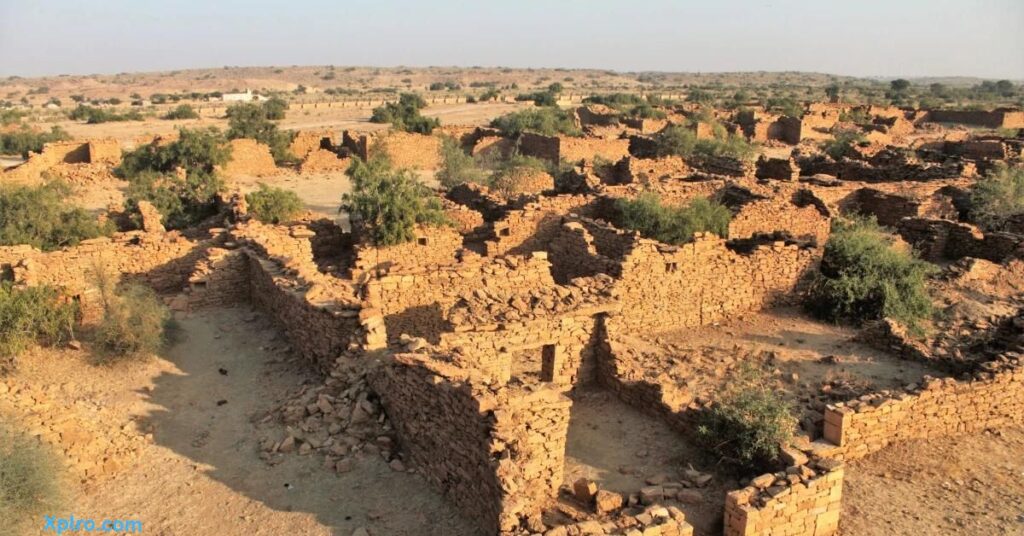
In the heart of the Thar Desert, a veil of mystery shrouds Kuldhara Village, an abandoned settlement near Jaisalmer. Once a vibrant community of Paliwal Brahmins, legend whispers of its abrupt desertion in the 19th century. A curse cast in anger? Oppressive taxes that drove them away? Whatever the reason, Kuldhara vanished overnight, leaving behind an eerie silence and exceptionally well-preserved ruins.
Walk through narrow alleys where time seems frozen. Dilapidated houses stand sentinel, their walls adorned with the faint echoes of laughter that once filled the air. Temples, intricately carved testaments to a forgotten faith, speak of a community deeply rooted in tradition.
Local Experiences:
• Traverse by Camel: Explore ancient routes and remote villages on a timeless camel safari.
• Immerse in Culture: Witness captivating Rajasthani music and dance performances under the stars.
• Sleep Under the Stars: Experience an unforgettable night at a desert campsite with bonfires, feasts, and cultural entertainment.
• Explore Desert Villages: Interact with local communities in villages like Khuri and Osian, and learn about their traditional way of life.
• Unleash Your Creativity: Participate in workshops and learn traditional Rajasthani art forms like block printing and embroidery.
• A Culinary Adventure: Savor delicious Rajasthani cuisine with bold flavors and local breads.
• Festivals of Color: Time your visit to coincide with a vibrant desert festival and witness cultural extravaganzas.
• Capture the Essence: Join a photography expedition to capture the desert’s beauty through your lens.
• Witness Nature’s Palette: Experience magical sunrises and sunsets over the dunes and desert landscape.
• Stargaze in Awe: Marvel at the clear night skies and learn about constellations from local guides.
Travel tips:
- Lightweight & Breathable: Opt for loose, breathable clothing that covers your arms and legs for sun and sand protection.
- Sun Essentials: Pack sunscreen, sunglasses, a wide-brimmed hat, and sturdy shoes or sandals.
- Hydration is Key: Carry plenty of water, especially during excursions and camel safaris. Dehydration sets in quickly in the desert.
- Respect Local Culture: Dress modestly, especially at religious sites. Ask permission before photographing people.
- Beat the Heat: Be aware of extreme temperatures. Seek shade during peak sun hours and avoid strenuous activities in the hottest part of the day. Pack any needed medication and a first-aid kit.
- Travel Insurance: Consider travel insurance that covers medical emergencies and trip cancellations, including adventure activities like camel safaris.
- Local Currency: Carry enough Indian Rupees (Rupees) as ATMs are limited in rural areas.
- Transportation: Plan your inter-city travel in advance. Taxis, buses, and rental cars are available, but book early during peak season.
- Guides & Tours: Enhance your experience with local guides or organized tours for safaris, treks, and cultural activities. They offer valuable insights into the region’s history, wildlife, and traditions.
- Respectful Photography: Rajasthan’s beauty is perfect for capturing memories. Be mindful of local customs, especially in religious places and villages. Always ask permission before photographing people.
- Pack for Extremes: Rajasthan experiences hot days and cooler nights. Check weather forecasts and pack accordingly. Be prepared for sudden changes, especially during the monsoon season (July-September).
- Travel in Groups: Explore remote areas or embark on desert excursions with companions. Inform someone of your itinerary and expected return time, particularly if traveling solo.
- Festivals & Events: Check local calendars for festivals and cultural events happening during your visit. Participating offers a unique glimpse into Rajasthan’s vibrant traditions.
Conclusion
India’s beauty unfolds from the tranquil backwaters of Kerala to the rugged Thar Desert. Eco-tourism unlocks a deeper connection to these diverse landscapes. It’s about traveling responsibly, minimizing your environmental footprint, and supporting local communities and conservation efforts. Xplro.com curates eco-friendly itineraries, connecting you with authentic experiences that benefit both people and the planet. Whether you seek serenity in Sikkim’s forests or marvel at Andaman marine life, travel consciously with Xplro.com. From supporting conservation to minimizing plastic use, every responsible choice you make paves the way for future generations to experience India’s magic.
FAQs
What is the Thar Desert?
- The Thar Desert, also known as the Great Indian Desert, is a vast arid region located primarily in northwestern India, spanning parts of Rajasthan, Gujarat, Punjab, and extending into Pakistan. It is characterized by its expansive sand dunes, rocky terrain, and sparse vegetation.
Where is the Thar Desert located?
- The Thar Desert is situated predominantly in the state of Rajasthan in northwestern India. It extends into the southeastern regions of Pakistan and touches portions of Gujarat and Punjab in India.
When is the best time to visit the Thar Desert?
- The optimal time to visit the Thar Desert is during the winter months, from October to February. During this period, the weather is pleasant with moderate daytime temperatures and cooler nights, ideal for exploring the desert’s attractions comfortably.
What are the popular attractions in the Thar Desert?
- Key attractions in the Thar Desert include Jaisalmer Fort, Sam Sand Dunes, Desert National Park, Patwon Ki Haveli, camel safaris, and cultural festivals such as the Desert Festival in Jaisalmer.
What activities can I do in the Thar Desert?
- Visitors can engage in camel safaris, jeep excursions across sand dunes, cultural performances showcasing traditional Rajasthani music and dance, exploration of historical forts and havelis, visits to desert wildlife sanctuaries, and sampling authentic Rajasthani cuisine.
Is it safe to visit the Thar Desert?
- Yes, visiting the Thar Desert is generally safe. However, travelers should take precautions against extreme temperatures, stay hydrated, and respect local customs and guidelines to ensure a safe and enjoyable experience.
What should I pack for a trip to the Thar Desert?
- Essential items to pack include lightweight and breathable clothing suitable for desert conditions, sunscreen, sunglasses, a wide-brimmed hat for sun protection, comfortable walking shoes or sandals, and an adequate supply of water to stay hydrated.
How do I reach the Thar Desert?
- The Thar Desert is accessible via major cities like Jaisalmer, Jodhpur, and Bikaner, which have airports, railway stations, and well-connected road networks. These cities serve as gateways to various desert destinations.
What is unique about the culture of the Thar Desert?
- The culture of the Thar Desert is distinguished by its vibrant traditions, including folk music and dance forms, colorful attire, intricate handicrafts such as embroidery and pottery, and a hospitality that reflects the heritage and lifestyle of desert communities.
Are accommodations available in the Thar Desert?
- Yes, there are various accommodation options ranging from luxury desert camps and heritage hotels to budget guesthouses and homestays. These accommodations cater to a range of preferences, offering experiences from rustic to luxurious.
What are some tips for a memorable desert safari experience?
- To enhance your desert safari experience, consider booking in advance during peak seasons, choosing a reputable tour operator, respecting desert wildlife and vegetation, carrying essentials like sunscreen and water, and being prepared for fluctuating weather conditions.
Are there any local festivals celebrated in the Thar Desert?
- Yes, the Thar Desert hosts cultural festivals such as the Desert Festival in Jaisalmer. These festivals feature traditional music and dance performances, camel races, competitions like turban tying, and provide insights into Rajasthani culture and traditions.




